by NinaI’ve designed this quieting sequence—which can be helpful if you are suffering from stress, anxiety, or just need to chill—to prepare you to practice supported seated forward bends. If done with the right amount of support, seated forward bends can be very quieting poses. However, unless you are naturally very flexible in your hamstrings (the backs of your thighs) and your back muscles, you do need to experiment a bit with different types of propping to find the type of support that will the poses feel nurturing and calming rather than uncomfortable and aggravating.Basically there are two different ways to support yourself in a forward bend. The first one way—which Baxter mentioned in his post Male Body Image and Yoga as a revelation to him—is to use a bolster or rolled blanket under your straight leg or legs. For example, here is Baxter in Seated Forward Bend (Paschimottanasana).
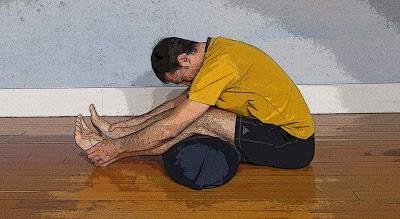 See Getting Comfortable in Forward Bends for information about this type of support forward bends. In this version, you do round your back a bit. If rounding your back isn’t a good idea for you (due to back problems) or just doesn’t feel good to you, you can try supporting your hands and head on a chair the way I’m going in this photo (a version works really well for me):
See Getting Comfortable in Forward Bends for information about this type of support forward bends. In this version, you do round your back a bit. If rounding your back isn’t a good idea for you (due to back problems) or just doesn’t feel good to you, you can try supporting your hands and head on a chair the way I’m going in this photo (a version works really well for me):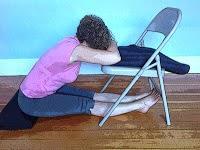 See Soothing Yourself with Supported Forward Bends for information about this type of supported forward bends. In this version, you keep your spine straight, so you need to be sure the chair seat is high enough to support your head without rounding your spine (it might be necessary to put some folded blankets on top of the chair seat).
See Soothing Yourself with Supported Forward Bends for information about this type of supported forward bends. In this version, you keep your spine straight, so you need to be sure the chair seat is high enough to support your head without rounding your spine (it might be necessary to put some folded blankets on top of the chair seat).This sequence begins with leg stretches to open your hips and lengthen your hamstrings (the backs of your thighs). The Half Dog pose and Standing Forward bend also stretch your legs while at the same time lengthening your spine and opening your shoulders. The standing poses also open your hips, lengthen your hamstrings, lengthen your spine, and open your shoulders. But because these are more active, demanding poses, they can help you release physical stress from your body to prepare you for sitting quietly.
The Cobbler’s pose (Baddha Konasana) is a seated pose that will transition you from the active poses to quieter ones, while at the same time preparing your hips for the first seated forward bend.
After the two seated forward bends, practicing Child’s pose, either with or without support, will continue to quiet you, while at the same time releasing your lower back. If this pose doesn’t work for you, you can skip it.
Ending with Legs Up the Wall or Easy Inverted pose continues to quiet your nervous system while resting your lower back.
Quieting Sequence
Standing Leg Stretches (Padangusthasana), 30 seconds to 1.5 minutes per side. Follow the instructions here.
 Downward-Facing Dog pose (Adho Mukha Svanasana) with Chair, 30 seconds to 1 minute. Follow the instructions here.
Downward-Facing Dog pose (Adho Mukha Svanasana) with Chair, 30 seconds to 1 minute. Follow the instructions here.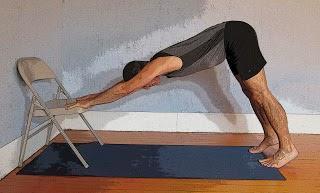 Standing Forward Bend (Uttanasana) with Chair, 30 seconds to 1 minute. Depending on the length of your torso, you’ll need stand some distance away from the front of your chair seat. As you come into the pose, focus on bending from your hip joints, not rounding your back. Keeping your back straight (step back if necessary), rest your head on your folded arms, tugging your forehead skin gently toward your nose. If the chair seat is not high enough for you, place folded blankets on the seat to raise it.
Standing Forward Bend (Uttanasana) with Chair, 30 seconds to 1 minute. Depending on the length of your torso, you’ll need stand some distance away from the front of your chair seat. As you come into the pose, focus on bending from your hip joints, not rounding your back. Keeping your back straight (step back if necessary), rest your head on your folded arms, tugging your forehead skin gently toward your nose. If the chair seat is not high enough for you, place folded blankets on the seat to raise it.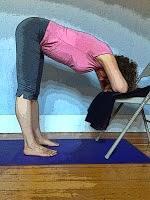 Warrior 2 pose (Virbradrasana), 30 seconds to 1 minute per side. Follow the instructions here. For this practice, focus on moving slowly in and out of the pose to maintain quietness.
Warrior 2 pose (Virbradrasana), 30 seconds to 1 minute per side. Follow the instructions here. For this practice, focus on moving slowly in and out of the pose to maintain quietness. 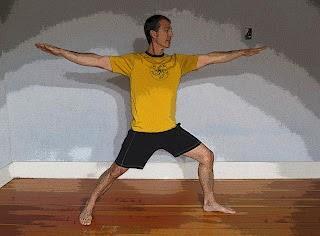 Triangle Pose (Trikonasana), 30 seconds to 1 minute per side. As you come into the pose, focus on lifting up and over your hip joint as you keep lengthening your spine. Move slowly in and out of the pose to maintain quietness. Use enough support for your bottom hand to keep the pose comfortable.
Triangle Pose (Trikonasana), 30 seconds to 1 minute per side. As you come into the pose, focus on lifting up and over your hip joint as you keep lengthening your spine. Move slowly in and out of the pose to maintain quietness. Use enough support for your bottom hand to keep the pose comfortable.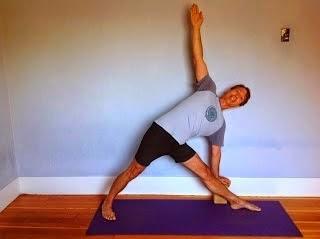 Extended Side Angle Pose (Parsvakonasana), 30 seconds to 1 minute per side. After you bend your front knee, focus on lifting up and over your hip joint as you keep lengthening your spine to come into the pose. Move slowly in and out of the pose to maintain quietness. Use enough support for your bottom hand to keep the pose comfortable.
Extended Side Angle Pose (Parsvakonasana), 30 seconds to 1 minute per side. After you bend your front knee, focus on lifting up and over your hip joint as you keep lengthening your spine to come into the pose. Move slowly in and out of the pose to maintain quietness. Use enough support for your bottom hand to keep the pose comfortable. Downward-Facing Dog pose (Adho Mukha Svanasana), 30 seconds to 1 minute per side. Follow the instructions here. Do we have them.
Downward-Facing Dog pose (Adho Mukha Svanasana), 30 seconds to 1 minute per side. Follow the instructions here. Do we have them.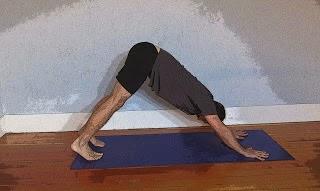 Cobbler’s Pose (Baddha Konasana), 1.5 minutes. Sit on a support that is high enough so your knees are at the same level with or below your hips (version 1 or 2 in this video). Focus on lengthening your spine up as your relax your hip joints.One-Legged Forward Bend (Janu Sirsasana) with Bolster or Chair, 1 to 2 minutes per side. Start by sitting on a support with two straight legs, then bend your right knee and let your right leg drop out to the side in a half Cobbler's pose. Place your bolster under your left leg or, if you're using the chair, have your left leg under the chair seat. Then, to come into the forward bend, focus on bending from your hip joints, not rounding your back. If you are doing the version with a support under your straight leg, you can allow you back to gently round once you are in the pose. If you are doing the version with a chair, keep your back straight. Rest your head on your folded arms, tugging your forehead skin gently toward your nose. If you are using the chair seat and it is not high enough for you, place folded blankets on the seat to raise it. We don't have photos of this pose, but picture the next pose with one bent leg and one straight leg.
Cobbler’s Pose (Baddha Konasana), 1.5 minutes. Sit on a support that is high enough so your knees are at the same level with or below your hips (version 1 or 2 in this video). Focus on lengthening your spine up as your relax your hip joints.One-Legged Forward Bend (Janu Sirsasana) with Bolster or Chair, 1 to 2 minutes per side. Start by sitting on a support with two straight legs, then bend your right knee and let your right leg drop out to the side in a half Cobbler's pose. Place your bolster under your left leg or, if you're using the chair, have your left leg under the chair seat. Then, to come into the forward bend, focus on bending from your hip joints, not rounding your back. If you are doing the version with a support under your straight leg, you can allow you back to gently round once you are in the pose. If you are doing the version with a chair, keep your back straight. Rest your head on your folded arms, tugging your forehead skin gently toward your nose. If you are using the chair seat and it is not high enough for you, place folded blankets on the seat to raise it. We don't have photos of this pose, but picture the next pose with one bent leg and one straight leg.Seated Forward Bend (Paschimottanasana) with Bolster or Chair, 3 minutes if possible. Start by sitting on a support. Then, place a bolster or rolled blankets under both legs or, if you are using th chair, lengthen both legs under the chair seat. As you come into the pose, focus on bending from your hip joints, not rounding your back. If you are doing the version with a support under your straight leg, you can allow you back to gently round once you are in the pose. If you are doing the version with a chair, keep your back straight. Rest your head on your folded arms, tugging your forehead skin gently toward your nose. If you are using the chair seat and it is not high enough for you, place folded blankets on the seat to raise it.
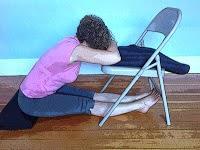
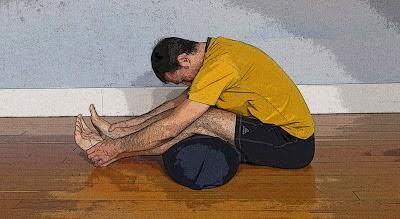 Child’s Pose (Balasana), with or without support, 1 to 3 minutes. For instructions on the supported version, see here. If you are doing the supported version, make sure to turn your head to the second side halfway through the pose.
Child’s Pose (Balasana), with or without support, 1 to 3 minutes. For instructions on the supported version, see here. If you are doing the supported version, make sure to turn your head to the second side halfway through the pose.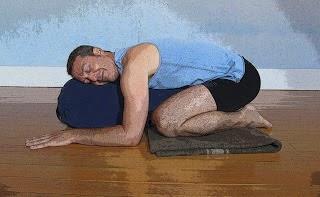 Legs Up the Wall pose (Viparita Karani) or Easy Inverted Pose, 5 to 15 minutes. For instructions Legs Up the Wall Pose and Easy Inverted Pose. If it is comfortable for you, support yourself on the bolster or blankets so that your lower back is curved again (letting your tailbone tip down off the support).
Legs Up the Wall pose (Viparita Karani) or Easy Inverted Pose, 5 to 15 minutes. For instructions Legs Up the Wall Pose and Easy Inverted Pose. If it is comfortable for you, support yourself on the bolster or blankets so that your lower back is curved again (letting your tailbone tip down off the support).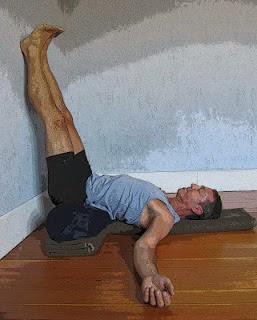
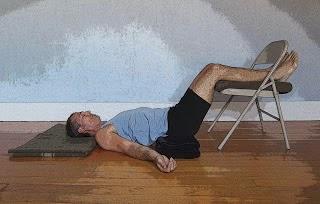 Subscribe to YOGA FOR HEALTHY AGING by Email ° Follow Yoga for Healthy Aging on Facebook
Subscribe to YOGA FOR HEALTHY AGING by Email ° Follow Yoga for Healthy Aging on Facebook

